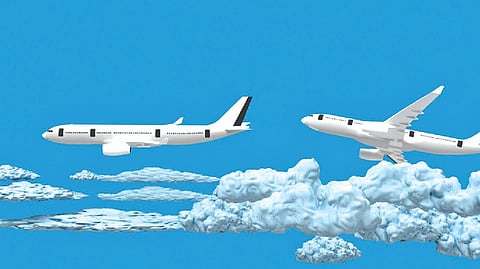

WASHINGTON: Countless travellers have experienced the distinct anxiety-inducing sensation of turbulence on flights: Eyes squeezed shut, hands clamped to the armrests for dear life, bracing for the roller coaster to come. Recent incidents have left dozens of passengers with injuries. Last month, seven passengers on a Lufthansa flight from Texas to Frankfurt were hospitalized with minor injuries after their plane encountered severe turbulence as it flew over Tennessee. And in December, about two dozen people, including an infant, were hurt on a Hawaiian Airlines flight from Phoenix to Honolulu that hit rough air shortly before landing.
The recent reports raise questions about whether turbulence is getting more frequent and intense. We spoke to a handful of experts to learn more about the tricky-to-predict weather phenomenon. Here’s what they said. What is turbulence? Turbulence is unstable air movement that is caused by changes in wind speed and direction, such as jet streams, thunderstorms, and cold or warm weather fronts. It can range in severity, causing minor to dramatic changes in altitude and air speed.
It’s not just associated with inclement weather, but can also occur when skies appear placid. And it can be invisible both to the eye and weather radar. There are four classifications for turbulence: light, moderate, severe and extreme. In cases of extreme turbulence, pilots can lose control of the airplane and there can even be structural damage to the aircraft, according to the National Weather Service.
Is turbulence increasing? And if so, why? Recent research indicates that turbulence is rising and that this change is sparked by climate change, specifically elevated carbon dioxide emissions affecting air currents.
Paul Williams, a professor of atmospheric science at the University of Reading in England, has studied turbulence for more than a decade. Dr. William’s research has found that clear air turbulence, which occurs most frequently at high altitudes and in winter, could triple by the end of the century. He said that this type of turbulence, of all categories, is increasing around the world at all flight altitudes. His research suggests that we could encounter bumpier flights in the coming years, which could potentially result in more passenger and crew injuries. How is turbulence monitored and measured? Meteorologists rely on a variety of different algorithms, satellites and radar systems to produce detailed aviation forecasts for conditions such as cold air, wind speed, thunderstorms and turbulence. They flag where and when turbulence might happen. Jennifer Stroozas, a meteorologist at the National Weather Service’s Aviation Weather Center, called turbulence “definitely one of the more challenging things to predict.”
Using these forecasts, in addition to guidance from air traffic controllers, pilots attempt to skirt turbulent areas by adjusting their altitude to find the smoothest ride. This means flying higher or lower than the altitude where forecasters predict turbulence, and potentially burning more fuel than initially anticipated, an endeavor that can be costly.
Chung is a travel reporter for NYT©2023
The New York Times
Visit news.dtnext.in to explore our interactive epaper!
Download the DT Next app for more exciting features!
Click here for iOS
Click here for Android